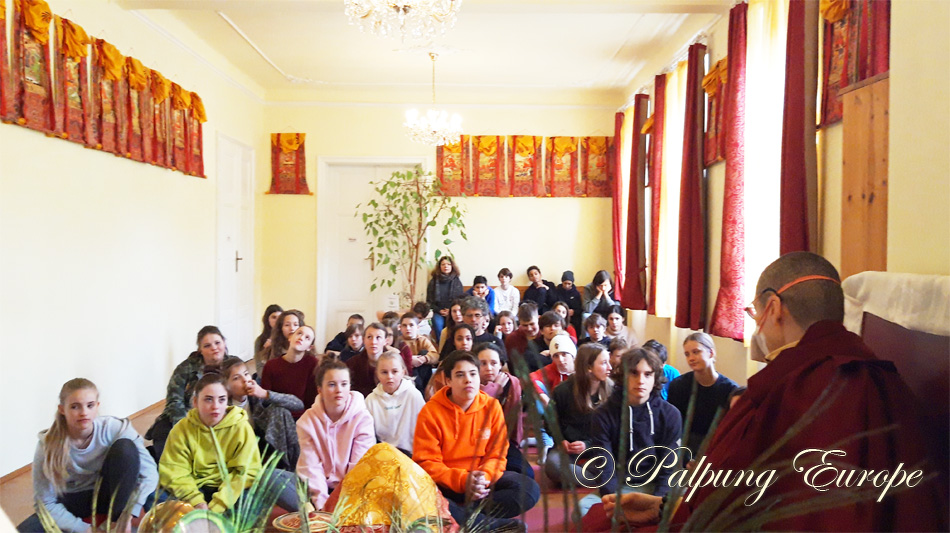Buddhism in Austria – A great responsibility
After having attained enlightenment, Buddha Shakyamuni remained silent for seven weeks and only startet to teach in Deer Park and turned the wheel of dharma for the first time at the request of the five ascetics with whom he had earlier practiced and whom he left, as he understood their path to be too strict, not providing the means to manifest ultimate reality. He manifested the Four noble truths (the truth of suffering, the truth of the cause of suffering, the truth of the cessation of suffering and the path to lead to freedom of suffering), the recognition of all-perasive suffering and the freedom from it, via the path. Practitioners of this vehicle are called Theravada Buddhists.
During the second turning of the wheel, Buddha manifested the transmission of emptiness and bodhicitta, the awakened heart. Practitioners of this vehicle are called Mahayana Buddhists.
དེ་ལ་དང་པོ་བྱང་སེམས་སྦྱོང་བ་ནི།
ཀུན་རྫོབ་སེམས་བསྐྱེད་ཉིད་ཡིན་དེ་ལ་ཡང་།
འགྲོ་བར་འདོད་དང་འགྲོ་བཞིན་པ་འདྲ་བའི།
སྨོན་འཇུག་གཉིས་སོ་སྨོན་པ་སེམས་བསྐྱེད་ནི།། །།
First, develop bodhicitta.
Concerning the arousal of relative bodhicitta,
It takes the bodhicitta of aspiration, which is like wanting to go somewhere
And the bodhicitta of application, which is like actually going there.
(Situ Panchen Chökyi Jungne: Instructions on the Fivefold Mahamudra by Situ Chökyi Jungne.
Translation: © Palpung Europe
During the third turning of the wheel, the third vehicle of the Buddhadharma which took place at different places, Buddha manifested Buddha Nature, the basic essence of all sentient beings, as much as their final destination. Those are Buddha Shakyamuni’s transmissions on which basis he manifested theVajrayana.Practitioners of this vehicle are called Vajrayana Buddhists.
འགྲོ་བའི་རང་བཞིན་རྟག་ཏུ་སངས་རྒྱས་ཀྱང་།
མ་རྟོགས་དབང་གིས་མཐའ་མེད་འཁོར་བར་འཁྱམས།
སྡུག་བསྔལ་མུ་མཐའ་མེད་པའི་སེམས་ཅན་ལ།
བཟོད་མེད་སྙིང་རྗེ་རྒྱུད་ལ་སྐྱེ་བར་ཤོག། །།
Beings’ inherent nature is always Buddha.
Due to them not recognizing it, they incessantly wonder around in Samsara.
May for all beings full of boundless, ceaseless suffering
Overwhelming compassion be born in our continuum!
(Rangjung Dorje: The Aspiration of Mahamudra)
Translation: © Palpung Europe
The teachings of the fourth historic Buddha, Buddha Shakyamuni have been unbrokenly transmitted in this world for approximately 2600 years. Since then, people have been following his example, have been using the means and methods to practice spirituality, to ripen their mindstream and to become equal to their idol, to attain the same result: complete buddhahood, a state of mind that is absolutely freed of any stain of disturbing emotions. Although one might say the core instructions accord common sense, once reckoned closely they are deep and complex, profound and all-inclusive, hardly graspable for our conditioned mind.
Buddhists practice in order to avoid, conquer and transform their disturbing emotions with a broad variety of methods into a pantheon of wisdom of various activities. These methods and means are being passed on from teacher to disciple, according to the student’s ability, within the three vehicles, Theravada, Mahayana and Vajrayana and so the basic message, or guideline for practicing Buddhists is absolutely simple and easy to remember:
སྡིག་པ་ཐམས་ཅད་མི་བྱ་སྟེ།
དགེ་བ་ཕུན་སུམ་ཚོགས་པར་སྤྱད།
རང་གི་སེམས་ནི་ཡོངས་སུ་འདུལ།
འདི་ནི་སངས་རྒྱས་བསྟན་པ་ཡིན།། །།
Refrain from all unvirtuous deeds,
Practice virtue in abundance
Tame your own mind totally.
This is the Buddha’s teaching.
(Buddha Shakyamuni: Pratimoksasutra)
Translation: © Palpung Europe
In Austria, the Buddhadharma is established in accordance with the Three turnings of the Wheel and all teachings with their methods to tame our mind are represented. This is an enormeous, undescribable wealth. A treasure which will benefit the individual, society, the country itself. By striving to becoming equal to our sacred idol, the perfect Buddha, we Buddhists can inspire others to work on themselves to transform negativity. By radiating happiness and contentment we can produce a great outcome even within the smallest framework: through exemplifying and simply being. An honest smile is not in need of words, it simply sets fire and perpetuates. It produces peace in mind.
Therefore, practitoners of the Buddhadharma bear a great responsibility: to practice the lineage Buddha Shakyamuni’s in absolute pure form, unaltered, to not change, shorten or align it with changing values and society’s structures.
Buddha’s direct words in the Kangyur (the Kangyur comprises Buddha Shakyamuni’s direct words in 108 texts and 102 volumes in the Derge Kangyur) were commented by enligthened Indian and Tibetan masters throughout the centuries in the Tengyur (the Tengyur comprises all those commentaries of realized Indian and Tibetan masters in 213 volumes in the Derge Tengyur). They give us all the instructions how to understand and explain Buddha’s teachings which makes them independent from time and space and universally relevant, fit to transcend culture, society, conditions and changes by remaining practicable, comprehensive and significant, not in need of new interpretations on basis of changing values and structures.







